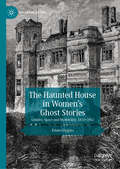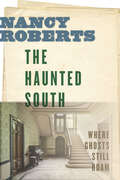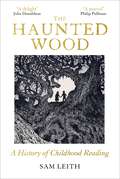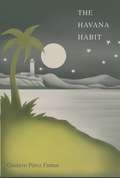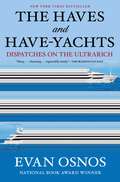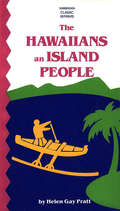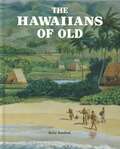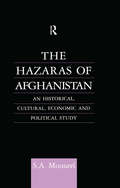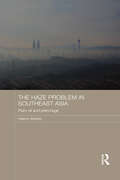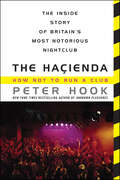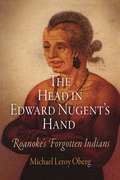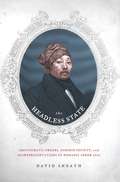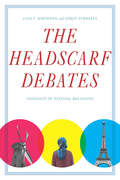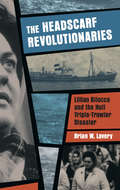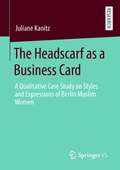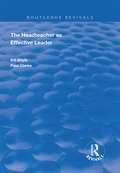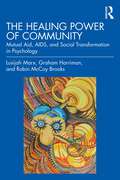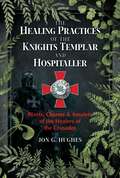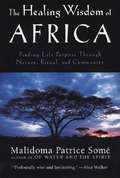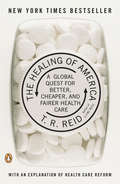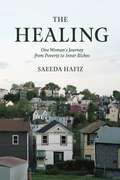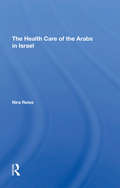- Table View
- List View
The Haunted House in Women’s Ghost Stories: Gender, Space and Modernity, 1850–1945 (Palgrave Gothic)
by Emma LigginsThis book explores Victorian and modernist haunted houses in female-authored ghost stories as representations of the architectural uncanny. It reconsiders the gendering of the supernatural in terms of unease, denial, disorientation, confinement and claustrophobia within domestic space. Drawing on spatial theory by Gaston Bachelard, Henri Lefebvre and Elizabeth Grosz, it analyses the reoccupation and appropriation of space by ghosts, women and servants as a means of addressing the opposition between the past and modernity. The chapters consider a range of haunted spaces, including ancestral mansions, ghostly gardens, suburban villas, Italian churches and houses subject to demolition and ruin. The ghost stories are read in the light of women’s non-fictional writing on architecture, travel, interior design, sacred space, technology, the ideal home and the servant problem. Women writers discussed include Elizabeth Gaskell, Margaret Oliphant, Vernon Lee, Edith Wharton, May Sinclair and Elizabeth Bowen. This book will appeal to students and researchers in the ghost story, Female Gothic and Victorian and modernist women’s writing, as well as general readers with an interest in the supernatural.
The Haunted South: Where Ghosts Still Roam
by Nancy RobertsThe Old South comes to supernatural life in this classic collection of chilling tales from the “custodian of the twilight zone” (Southern Living).Nancy Roberts, known as the “First Lady of American Folklore,” is a topnotch storyteller and one of the few who both write and tell their own stories. For more than two decades, Ms. Roberts has documented ghost stories and interviewed hundreds of people throughout the United States.A nationally known author of twenty-three books, Ms. Roberts began her career with a series of ghost stories written for The Charlotte Observer. Carl Sandburg sent her word that her stories were good, suggesting “they should be a book.” Since then her books have won her a certificate of commendation from the American Association for State and Local History and a nomination for the Great Western Writer’s Spur Award.The Haunted South includes tales about . . . An angel sighting in the North Carolina mountainsA poltergeist occurrence that drew trainloads of spectators to Jessup, GeorgiaA ghostly warning in Atlanta presaging a major plane crashA North Carolina tavern where unsuspecting travelers were murderedAn omen of death brought by South Carolina’s “Gray Lady”The apparition of an Alabama Railroad Robin HoodA ghost ship off North Carolina’s Outer BanksPraise for Nancy Roberts“Ghost hunter/author Nancy Roberts has put together as shivery a selection of other worldly tales as you’re likely to find anywhere . . . And whether you believe in ghosts or not, these tales are guaranteed to give you a chill, especially before you go into a dark room alone.” —Southern Living
The Haunted Wood: A History of Childhood Reading
by Sam Leith*A Sunday Times, Irish Times, Financial Times, Independent, Daily Mail, TLS, Economist, Prospect, Evening Standard and New Statesman Book of the Year 2024* Can you remember the first time you fell in love with a book? The stories we read as children matter. The best ones are indelible in our memories; reaching far beyond our childhoods, they are a window into our deepest hopes, joys and anxieties. They reveal our past – collective and individual, remembered and imagined – and invite us to dream up different futures. In a pioneering history of the children&’s literary canon, The Haunted Wood reveals the magic of childhood reading, from the ancient tales of Aesop, through the Victorian and Edwardian golden age to new classics. Excavating the complex lives of our most beloved writers, Sam Leith offers a humane portrait of a genre and celebrates the power of books to inspire and console entire generations. *** 'A MARVEL' PHILIP PULLMAN 'A DELIGHT' JULIA DONALDSON 'GLORIOUSLY ENTERTAINING' TOM HOLLAND
The Haunting of the Mexican Border: A Woman's Journey
by Kathryn FergusonThe Haunting of the Mexican Border is a woman&’s view of the violence and generosity of the border. For fifteen years beginning in the 1980s, Kathryn Ferguson made documentary films in Mexico&’s Sierra Madre. As she traveled south, she encountered people who were traveling north, and she learned that the border at which they converged was deadly. Drawing on her own experiences, this book explores how US immigration policies erode the lives of ordinary citizens on both sides of the border.
The Havana Habit
by Gustavo Pérez FirmatCuba, an island 750 miles long, with a population of about 11 million, lies less than 100 miles off the U.S. coast. Yet the island's influences on America's cultural imagination are extensive and deeply ingrained. In the engaging and wide-ranging "Havana Habit", writer and scholar Gustavo Perez Firmat probes the importance of Havana, and of greater Cuba, in the cultural history of the United States. Through books, advertisements, travel guides, films, and music, he demonstrates the influence of the island on almost two centuries of American life. From John Quincy Adams' comparison of Cuba to an apple ready to drop into America's lap, to the latest episodes in the lives of the 'comic comandantes and exotic exiles', and to such notable Cuban exports as the rumba and the mambo, cigars and mojitos, the Cuba that emerges from these pages is a locale that Cubans and Americans have jointly imagined and inhabited. The "Havana Habit" deftly illustrates what makes Cuba, as Perez Firmat writes, "so near and yet so foreign".
The Haves and Have-Yachts: Dispatches on the Ultrarich
by Evan OsnosFrom New York Times bestselling and National Book Award–winning author Evan Osnos comes a timely and provocative collection of essays exploring American oligarchy and the culture of excess, providing a wry, unfiltered look at how the ultrarich shape—and sometimes warp—our social and political landscape.The ultrarich hold more of America&’s wealth than they did in the heyday of the Carnegies and Rockefellers. Here, Evan Osnos&’s incisive reportage yields an unforgettable portrait of the tactics and obsessions driving this new Gilded Age, in which superyachts, luxury bunkers, elite tax dodges, and a torrent of political donations bespeak staggering disparities of wealth and power. With deft storytelling and meticulous reporting, this is a book about the indulgences, incentives, and psychological distortions that define our economic age. In each essay, Osnos delves into a world that is rarely visible, from the outrageous to the fabulous to the ridiculous: a private wealth manager who broke with members of an American dynasty and spilled their secrets; the pop stars who perform at lavish parties for thirteen-year-olds; the status anxieties that spill out of marinas in Monaco and Palm Beach like real-world episodes of Succession and The White Lotus; the ethos behind the largest Ponzi scheme in Hollywood history; the confessions of disgraced titans in a &“white-collar support group.&” A celebrated political reporter, Osnos delves into the unprecedented Washington influence of Silicon Valley and Wall Street, drawing on in-depth interviews with Mark Zuckerberg and other billionaires, about their power and the explosive backlash it stirs. Originally published in The New Yorker, these essays have been revised and expanded to deliver an unflinching portrait of raw ambition, unimaginable fortune, and the rise of America&’s modern oligarchy. Osnos&’s essays are a wake-up call—a case against complacency in the face of unchecked excess, as the choices of the ultrarich ripple through our lives. Entertaining, unsettling, and eye-opening, The Haves and the Have-Yachts couldn&’t be more relevant to today&’s world.
The Hawaiians an Island People
by Helen Gay Pratt"The old life described in this book disappeared long ago, but something of its heritage has, in Hawaii, become the heritage of all who live there today." With these words from the introduction to The Hawaiians: An Island People, Helen Gay Pratt invites her readers to become acquainted with Hawaii's original inhabitants and their fascinating way of life.
The Hawaiians of Old
by Betty Dunford Lilinoe Andrews Mika'Ala Ayau Liana I. Honda Julie Stewart WilliamsCovers the formation of the Hawaiian islands; the arrival of plants, animals, and the first people; and the way of life of the ancient Hawaiians.
The Hazaras of Afghanistan: An Historical, Cultural, Economic And Political Study
by S. A. MousaviStudy of the second largest but least well-known ethnic group in Afghanistan that also confronts the taboo subject of Afghan national identity. Largely Farsi-speaking Shi'ias, the Hazaras traditionally inhabited central Afghanistan, but because of the war are now widely scattered.
The Hazards of Being Male: Surviving the Myth of Masculine Privilege
by Herb GoldbergTODAY ONE GREAT DIFFERENCE BETWEEN MEN AND WOMEN IS THAT WOMEN AT LEAST KNOW THEY ARE OPPRESSED. Men have heard for as long as they can remember that it is a "man's world" and that they are the privileged sex. What they often discover too late is that their "privileges" include the right to live lives of mounting frustration, weariness and loneliness, and to die earlier than their female counterparts. For American men are raised by parents, conditioned by society, and often encouraged by women to play a role of lover-husband-parent-breadwinner-strong-and-silent-man whose impossible demands psychically cripple and eventually physically kill them. If you are a man, you will instantly recognize yourself and the dangers that threaten you when you read this book. If you are a woman who loves a man, you will want both him and yourself to read it.
The Haze Problem in Southeast Asia: Palm Oil and Patronage (Routledge Malaysian Studies Series)
by Helena VarkkeyDespite the efforts of Southeast Asian governments and of ASEAN, transboundary haze continues to be a major environmental problem in Southeast Asia. This book demonstrates that the issue is complex, and explains why efforts to solve the problem in purely political terms are ineffective, and likely to continue to be ineffective. The book shows how state-led, state-incentivised agribusiness development lies at the heart of the problem, leading to a large rise in palm oil production, with extensive clearing of forests, leading to deliberate or accidental fires and the resulting haze. Moreover, although the forest clearing is occurring in Indonesia, many of the companies involved are Malaysian and Singaporean; and, further, many of these companies have close relationships with the politicians and officials responsible for addressing the problem and who thereby have a conflict of interest. The author concludes by discussing the huge difficulties involved in overturning this system of 'patronage politics'.
The Haçienda: How Not to Run a Club
by Peter HookThe acclaimed and wildly outlandish inside account of England’s most notorious music club, The Hacienda, from Peter Hook, the New York Times bestselling author of Unknown Pleasures and co-founder of Joy Division and New Order—a story of music, gangsters, drugs, and violence, available for the first time in the United States.During the 1980s, The Hacienda would become one of the most famous venues in the history of clubbing—a celebrated cultural watershed alongside Studio 54, CBGBS, and The Whiskey—until its tragic demise.Founded by New Order and Factory Records, The Hacienda hosted gigs by such legendary acts as the Stone Roses, the Smiths, Bauhaus, Grandmaster Flash, Run DMC, Kurtis Blow, and Happy Mondays; gave birth to the “Madchester” scene; became the cathedral for acid house; and laid the tracks for rave culture and today’s electronic dance music. But over the course of its fifteen-year run, “Madchester” descended into “Gunchester” as gangs, drugs, greed, and a hostile police force decimated the dream.Told in Hook’s uproarious and uncompromising voice, The Hacienda is a funny, horrifying, and outlandish story of success, idealism, naïveté, and greed—of an incredible time and place that would change the face and sound of modern music.The Hacienda includes 32 photographs in 16-page four-color insert.
The Head in Edward Nugent's Hand
by Michael Leroy ObergRoanoke is part of the lore of early America, the colony that disappeared. Many Americans know of Sir Walter Ralegh's ill-fated expedition, but few know about the Algonquian peoples who were the island's inhabitants. The Head in Edward Nugent's Hand examines Ralegh's plan to create an English empire in the New World but also the attempts of native peoples to make sense of the newcomers who threatened to transform their world in frightening ways.Beginning his narrative well before Ralegh's arrival, Michael Leroy Oberg looks closely at the Indians who first encountered the colonists. The English intruded into a well-established Native American world at Roanoke, led by Wingina, the weroance, or leader, of the Algonquian peoples on the island. Oberg also pays close attention to how the weroance and his people understood the arrival of the English: we watch as Wingina's brother first boards Ralegh's ship, and we listen in as Wingina receives the report of its arrival. Driving the narrative is the leader's ultimate fate: Wingina is decapitated by one of Ralegh's men in the summer of 1586.When the story of Roanoke is recast in an effort to understand how and why an Algonquian weroance was murdered, and with what consequences, we arrive at a more nuanced and sophisticated understanding of what happened during this, the dawn of English settlement in America.
The Headless State: Aristocratic Orders, Kinship Society, and Misrepresentations of Nomadic Inner Asia
by David SneathIn this groundbreaking work, social anthropologist David Sneath aggressively dispels the myths surrounding the history of steppe societies and proposes a new understanding of the nature and formation of the state. Since the colonial era, representations of Inner Asia have been dominated by images of fierce nomads organized into clans and tribes-but as Sneath reveals, these representations have no sound basis in historical fact. Rather, they are the product of nineteenth-century evolutionist social theory, which saw kinship as the organizing principle in a nonstate society. Sneath argues that aristocratic power and statelike processes of administration were the true organizers of life on the steppe. Rethinking the traditional dichotomy between state and nonstate societies, Sneath conceives of a "headless state" in which a configuration of statelike power was formed by the horizontal relations among power holders and was reproduced with or without an overarching ruler or central "head." In other words, almost all of the operations of state power existed at the local level, virtually independent of central bureaucratic authority. Sneath's research gives rise to an alternative picture of steppe life in which aristocrats determined the size, scale, and degree of centralization of political power. His history of the region shows no clear distinction between a highly centralized, stratified "state" society and an egalitarian, kin-based "tribal" society. Drawing on his extensive anthropological fieldwork in the region, Sneath persuasively challenges the legitimacy of the tribal model, which continues to distort scholarship on the history of Inner Asia.
The Headless State: Aristocratic Orders, Kinship Society, and Misrepresentations of Nomadic Inner Asia
by David SneathIn this groundbreaking work, social anthropologist David Sneath aggressively dispels the myths surrounding the history of steppe societies and proposes a new understanding of the nature and formation of the state. Since the colonial era, representations of Inner Asia have been dominated by images of fierce nomads organized into clans and tribes—but as Sneath reveals, these representations have no sound basis in historical fact. Rather, they are the product of nineteenth-century evolutionist social theory, which saw kinship as the organizing principle in a nonstate society.Sneath argues that aristocratic power and statelike processes of administration were the true organizers of life on the steppe. Rethinking the traditional dichotomy between state and nonstate societies, Sneath conceives of a "headless state" in which a configuration of statelike power was formed by the horizontal relations among power holders and was reproduced with or without an overarching ruler or central "head." In other words, almost all of the operations of state power existed at the local level, virtually independent of central bureaucratic authority. Sneath's research gives rise to an alternative picture of steppe life in which aristocrats determined the size, scale, and degree of centralization of political power. His history of the region shows no clear distinction between a highly centralized, stratified "state" society and an egalitarian, kin-based "tribal" society. Drawing on his extensive anthropological fieldwork in the region, Sneath persuasively challenges the legitimacy of the tribal model, which continues to distort scholarship on the history of Inner Asia.
The Headscarf Debates: Conflicts of National Belonging
by Anna C. Korteweg Gökçe YurdakulThe headscarf is an increasingly contentious symbol in countries across the world. Those who don the headscarf in Germany are referred to as "integration-refusers." In Turkey, support by and for headscarf-wearing women allowed a religious party to gain political power in a strictly secular state. A niqab-wearing Muslim woman was denied French citizenship for not conforming to national values. And in the Netherlands, Muslim women responded to the hatred of popular ultra-right politicians with public appeals that mixed headscarves with in-your-face humor. In a surprising way, the headscarf—a garment that conceals—has also come to reveal the changing nature of what it means to belong to a particular nation. All countries promote national narratives that turn historical diversities into imagined commonalities, appealing to shared language, religion, history, or political practice. The Headscarf Debates explores how the headscarf has become a symbol used to reaffirm or transform these stories of belonging. Anna Korteweg and Gökçe Yurdakul focus on France, Germany, and the Netherlands—countries with significant Muslim-immigrant populations—and Turkey, a secular Muslim state with a persistent legacy of cultural ambivalence. The authors discuss recent cultural and political events and the debates they engender, enlivening the issues with interviews with social activists, and recreating the fervor which erupts near the core of each national identity when threats are perceived and changes are proposed. The Headscarf Debates pays unique attention to how Muslim women speak for themselves, how their actions and statements reverberate throughout national debates. Ultimately, The Headscarf Debates brilliantly illuminates how belonging and nationhood is imagined and reimagined in an increasingly global world.
The Headscarf Revolutionaries: Lillian Bilocca and the Hull Triple-Trawler Disaster
by Brian W. LaveryWinter 1968. Three Hull trawlers sink. One fishwife vows to change the law. A powerful story of death and survival. In the harsh Arctic seas of 1968, three trawlers from Hull's fleet sank in just three weeks. 58 men died. Lillian Bilocca put down her filleting knife, wrote a petition, and stormed into action. With her army of fishwives she took her battle to the docks and led a raid on Parliament. They changed the shipping laws, 'Big Lil' became an international celebrity. The lone survivor of the tragedies made headlines too. In a tight fishing community, it's dangerous to stand out.
The Headscarf as a Business Card: A Qualitative Case Study on Styles and Expressions of Berlin Muslim Women
by Juliane KanitzIn her book, Juliane Kanitz not only examines the frequently asked question of why Muslim women wear a headscarf, but also concentrates on how it is worn. She is concerned with the cultural, aesthetic and fashionable preferences of women and not primarily with the religious motives that are otherwise often the focus of attention. In addition to a contribution to research on the Muslim headscarf, the author presents theoretical and empirical supplements to Islamic fashion and Islam in Germany as a whole. She also discusses the debate on Europeanization, in which arguments against Muslims are put forward, and develops some perspectives on the topic of the headscarf in Germany that have not yet been taken into account, made possible by the new perspective of fashion.
The Headteacher as Effective Leader (Routledge Revivals)
by Paul Clarke Bill BoyleFirst published in 1998, this volume focuses on the range of crucial role that the headteacher must fulfil as the leader. It has become apparent that being a good manager and teacher is not enough, the headteacher has to be able to lead and communicate the vision of the school to the staff, pupils, parents and governors. The role includes auditing the needs of the school and leading the process of planning to meet its targets, balancing quality of provision and raising standards within the limits of the school environment. The roles of team builder, motivator and systems thinker are also essential. Finally the headteacher has the role of developing staff, and promoting self-development linked with school improvement.
The Healing Power of Community: Mutual Aid, AIDS, and Social Transformation in Psychology
by Robin McCoy Brooks Lusijah Marx Graham HarrimanThe Healing Power of Community offers a diverse cross section of interdisciplinary and depth-psychological perspectives in support of using mutual aid approaches in all levels of group and community practice as a remedy for individualism and social and political divisions, centering social justice.Written by three distinct voices who collaborated at the height of the AIDS crisis, the book begins with an autoethnographic study of Project Quest, an HIV/AIDS clinic established in 1989, before looking at how the lessons learnt from this clinic can be applied to our current global mental health climate. Filled with clinical and theoretical applications, chapters include content on what mutual aid communities are, rethinking professionalism and boundaries in a crisis, healing collective trauma, group psychotherapy, psychodrama, depth psychology, and how mental health professionals can support radical change of key structures in nonprofit clinics, public administration, private practice, and research. Arguing for their approach of radicalizing mental health and community-based practice today, the book examines how this can be achieved by moving beyond individual-level approaches, creating new frameworks to meet the mental health needs of our era in creative ways.This book is designed to engage clinical social workers and mental health care clinicians working in community-based mental health, as well as those involved in community psychology, collective trauma and grief, HIV/AIDS advocacy, policy making, and political advocacy.
The Healing Practices of the Knights Templar and Hospitaller: Plants, Charms, and Amulets of the Healers of the Crusades
by Jon G. Hughes• Presents a traditional &“cure-all&” or leechbook of the ailments the Crusaders would have encountered and the remedies their mediciners would have employed, including recipes for many cures and instructions • Includes a comprehensive herbal, listing all the medicinal plants and materials needed to make the remedies, potions, elixirs, and unctions of the cure-all • Details the author&’s travels in the steps of the Crusader physicians where he met with healers still employing the mediciners&’ practices During the Crusades, chivalric knightly orders, such as the Knights Templar and the Knights Hospitaller, brought along monastic mediciners to treat the sick and wounded. These mediciners not only employed the leading cures of medieval Europe but also learned new methods from the local folk-healers and Arabic healing traditions they encountered on their journeys. Presenting a traditional &“cure-all&” or leechbook of the Crusader physicians, the author shares a comprehensive encyclopedia of the ailments the Crusaders would have encountered and the remedies their mediciners would have employed. He details recipes for many cures and a range of magico-medical applications such as charms, spells, enchantments, and amulets used to address the new illnesses of strange and foreign lands. The author includes a detailed and comprehensive herbal, listing all the plants and materials needed to make and administer the remedies of the cure-all. He also details his travels in the steps of the Crusader physicians throughout Poland, the Czech Republic, Hungary, Malta, Morocco, and the island of Rhodes where he met with healers still following this healing path who shared their practices with him. Revealing how the healers of the Crusades helped elevate Western medical knowledge through the integration of wisdom from their Middle Eastern counterparts, Hughes shows how their legacy continues through the many effective remedies and healing modalities still in use today.
The Healing Wisdom of Africa: Finding Life Purpose Through Nature, Ritual, and Community
by Malidoma Patrice SoméThrough The Healing Wisdom of Africa, readers can come to understand that the life of indigenous and traditional people is a paradigm for an intimate relationship with the natural world that both surrounds us and is within us. The book is the most complete study of the role ritual plays in the lives of African people--and the role it can play for seekers in the West.
The Healing of America: A Global Quest for Better, Cheaper, and Fairer Health Care
by T. R. ReidA New York Times Bestseller, with an updated explanation of the 2010 Health Reform Bill Bringing to bear his talent for explaining complex issues in a clear, engaging way, New York Times bestselling author T. R. Reid visits industrialized democracies around the world--France, Britain, Germany, Japan, and beyond--to provide a revelatory tour of successful, affordable universal health care systems. Now updated with new statistics and a plain-English explanation of the 2010 health care reform bill, The Healing of America is required reading for all those hoping to understand the state of health care in our country, and around the world.T. R. Reid's newest book, A Fine Mess, will be published by Penguin Press in Spring 2017.
The Healing: One Woman's Journey from Poverty to Inner Riches
by Saeeda HafizIn this memoir of upward mobility through an unexpected route, a young black American woman signs up for lessons in yoga and clean eating as signifiers of her new middle class status, little realizing that her new lifestyle will bring her face to face with the inner demons fed by the domestic violence, addiction, and poverty she witnessed as a child.Graduating, getting established in your career, and dating another professional are things many young middle-class women expect to do and take for granted. But when your parents don't support you and you have siblings in prison, those milestones seem monumental. What does growing up poor do to your self-esteem? How do patterns of stress and family violence, poor diet and poor health continue to affect you even after you escape to a higher income bracket? And what can one woman do to turn around the cycle of racism, poverty, and intergenerational suffering? Hafiz gives a frank account of the anxiety and rewards of becoming "middle class" through a complete change of diet and adopting habits such as traveling and doing yoga. While her peers pursue one kind of African American dream by climbing the corporate ladder, Hafiz finds meaning in learning to cook macrobiotic food and practice meditation. By doing so, she recovers from chronic health conditions and heals from the family trauma she has inherited.
The Health Care Of The Arabs In Israel
by Nira ReissA study of the development of modern medical health services in Palestine until 1948 and in Israel, this book focuses on the interaction of state policy, class relations, voluntary organizations, and professional practice as they affect the level of participation of Arabs in the emergent health system.
